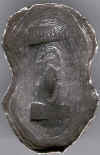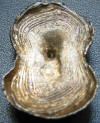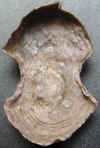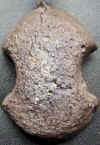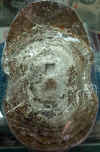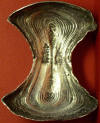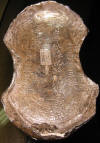The Ming Dynasty #2
Weight: 8 taels
Date: N/A
Inscriptions: 紋銀
Wen Yin (Wave Silver, or Fine Silver)
Notes:
A later type
Collection of Chang Huei Hsin
Weight: 374 grams/10 taels
Date: N/A
Inscriptions: 保山縣/羅石林
Bao Shan County (of the Yunnan Province)
Lo Shi Lin (The smith)
Notes:
Danny Cheng, the webmaster of Sycee Net, just acquired this Ming specimen. According to its shape, it is an early type. The inscription of the place name indicates that it was an official or tax silver cast in Yunnan. (Bao Shan County has been under the jurisdiction of Yong Chang Prefecture)
Generally, an early-type Ming official sycee was characterized by engraved inscriptions and the sizes of 12.5, 25, 50 taels, while a later type was stamped and in the sizes of 10, 20, 30,40 and 50 taels. The weight standard of this piece is in that usually found in the later type. It also confirms the practice in Yunnan during the late Ming period was to inscribe local tax silver by stamping, rather than engraving.
The Historical Currencies of Yunnan illustrates another early-type Ming Boat circulated in the late Ming Dynasty. It was inscribed by stamping with the place name of Her Ching Prefecture and the smith's name, and the layout of the two stamps is basically the same as of this piece.
We believe that Danny's Ming piece was a local tax silver circulated in the late Ming Dynasty. Used as an expedient way for handling local taxes, this kind of silver was not required to bear the inscriptions of the casting date, usage or title of tax levied, such as Mn/2. This shows that early type Ming Boats were still in use during the later stage of the Dynasty, even when the later type was already in wide circulation.
Weight: 38 grams/1 tael
Date: N/A
Inscriptions:
None
Notes:
An early type
Collection of the webmaster
Weight: 150 grams/4 tael
Date: N/A
Inscriptions:
None
Notes:
An early type
Collection of Tony Ma
Weight: 50 taels
Date: N/A
Inscriptions: 婁縣解/伍十兩匠陳升
Submitted by Lo County (of Jiangsu Province)
50 Taels, Smith Chen Shen
Chopmarks: 課
Tax
Notes:
A later type inscribed by engraving
Seen in trade
Weight: 20 taels
Date: N/A
Inscriptions: 金花銀
Golden Flowery Silver
Notes:
From the beginning of the 1st year of Zhen Tung Reign (1436 A.D.), taxpayers in southern China were allowed to pay taxes in the form of silver to replace agricultural produce which they had traditionally submitted. This change was made 62 years later after the Silver Ban dictated by the 1st emperor of the dynasty in the 8th year of Hong Wu (1375), and this new tax silver was named by the Ming government as 金花銀 "Golden Flowery Silver".
Square Troughs of the southern provinces in the Ching Dynasty were either a later type of Golden Flowery Silver or were strongly influenced by its form. More details are provided in "A Study on Square Troughs of the Southern Provinces During the Ching Dynasty"(清代南方諸省方鏪考)
Collection of Liu Chao Yuan
Weight: 1,000 grams/27 taels
Date: 1640 A.D.
Inscriptions: 寧鄉縣(崇禎)十三年新加漕糧募民水腳銀貳十七兩一定
Ning Hsiang County, the 13th Year (of Chong Zhen), a Lump of 27 Taels "Water Foot" (Canal Freight) Silver Collected from Taxpayers for the Newly Added Taxed Grain to be shipped via the Grand Canal.
Notes:
Collection of the webmaster
Weight: 50 taels
Date: 1643 A.D.
Inscriptions: 雲龍州呈解(崇禎)十六年秋糧地畝加派遼餉銀五十兩銀匠張□□
Submitted by Yun Lung District (in Yunnan Province), in the 16th Year (of Chong Zhen), Liao Ration Added on Autumn Land Tax, Silver of 50 Taels, Silversmith Chang XX.
Additional chop: 連
Lien (Connection, or a Last name)
Notes:
Seen in trade
Go to The Ming Dynasty #1
More Ming specimens in Museums: National Museum of Chinese History (Beijin, China). Hanaga (Hong Kong)
Return to Categories

